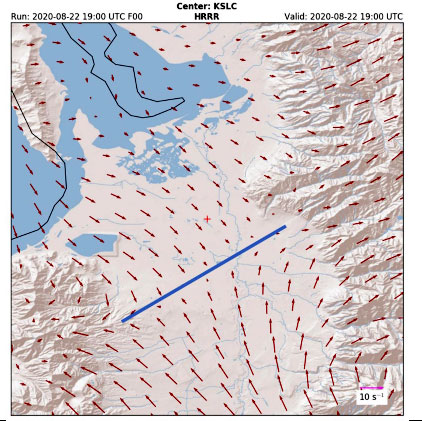- Principal Investigator: John Horel (University of Utah)
- Study Period: July 1, 2021 – December 31, 2022
- Funded by Science for Solutions Research Grant: $63,084
- DAQ Contact: Rachel Edie (redie@utah.gov)
We will determine the meteorological factors contributing to elevated ozone concentrations along the southern and eastern margins of the Great Salt Lake that serve as a source region for high ozone concentrations along the Wasatch Front. We hypothesize that multiple factors contribute to elevated ozone in the Farmington Bay region: (1) ozone precursors from the urban corridor (NOx and VOCs) and local biogenic precursors near freshwater ponds are transported by the nocturnal land breeze over the playa surfaces ; (2) actinic fluxes are elevated due to the high albedo over exposed playa surfaces; (3) initial development of the lake breeze concentrates precursors and ozone within the relatively shallow stable lake boundary layer; and (4) the lake breeze then transports ozone into the nearby urban regions later in the afternoon. This study ties directly to the overarching goals of the Science for Solutions program to improve understanding of summertime ozone pollution along the Wasatch Front. The primary foci for this study are Priority I- Source Contributions to Summer-Time Ozone and Priority V- Air Exchange Processes and Pollutants Mass Transport. We will improve understanding of the summer ozone exceedances exacerbated by emission sources and processes near the southern and eastern Farmington Bay regions and how air mass exchanges affect the transport of ozone and its precursors. This will involve examining air exchanges across the Great Salt Lake and between the polluted boundary layer and free troposphere that affect transport and mixing of key ozone precursors.
The Principal Investigators have extensive experience leading field campaigns and long-term monitoring efforts for atmospheric conditions and criteria pollutants along the Wasatch Front. The proposed study will extend that work based on the extensive amount of available data resources from 2015 through the project period to address our core hypothesis. Questions will be addressed using existing observations near the Great Salt Lake and along the Wasatch Front that have been archived from in-situ sensors on fixed and mobile platforms as well as numerical weather prediction model output. A small set of additional sensors will be deployed during summer 2021 and 2022 to fill gaps in critical locations that have not been sampled adequately before. The core task for this project is to evaluate from ozone observations and meteorological observations and model analyses the timing of buildup in ozone in the southern Farmington Bay region and subsequent transport into Davis and Salt Lake counties. Completion of this task will provide resources that are likely to enhance operational air quality forecasting and provide critical information to initialize and verify air chemistry models used to identify approaches to meet federal air quality standards.

